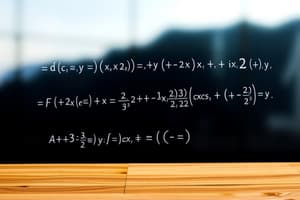Podcast
Questions and Answers
What does the Intermediate Value Theorem guarantee about continuous functions on a closed interval?
What does the Intermediate Value Theorem guarantee about continuous functions on a closed interval?
- They take on every value between their minimum and maximum. (correct)
- They must have a horizontal asymptote.
- They can only take on values at the endpoints.
- They may have discontinuities in the closed interval.
When evaluating the limit of a function as $x$ approaches a point, which situation could indicate a vertical asymptote?
When evaluating the limit of a function as $x$ approaches a point, which situation could indicate a vertical asymptote?
- The limit equals infinity. (correct)
- The limit is negative infinity. (correct)
- The limit exists and equals a finite number.
- The function is continuous at the point.
Which of the following correctly states the definition of the derivative using a limit?
Which of the following correctly states the definition of the derivative using a limit?
- f'(x) = lim_{h→0} (f(a) - f(x)) / (x - a)
- f'(x) = lim_{x→0} (f(x) - f(0)) / x
- f'(x) = lim_{h→0} (f(x+h) - f(x)) / h (correct)
- f'(x) = lim_{h→0} (f(x+h) - f(x)) / (h + a)
What is required to find the equation of a tangent line to a function at a given point?
What is required to find the equation of a tangent line to a function at a given point?
Which of the following represents a correct application of the Squeeze Theorem?
Which of the following represents a correct application of the Squeeze Theorem?
A horizontal asymptote indicates that the function approaches a specific finite value as $x$ approaches infinity.
A horizontal asymptote indicates that the function approaches a specific finite value as $x$ approaches infinity.
If the limit of a function as $x$ approaches a point is equal to the function's value at that point, the function is discontinuous at that point.
If the limit of a function as $x$ approaches a point is equal to the function's value at that point, the function is discontinuous at that point.
The derivative of a function at a point describes the slope of the tangent line to the graph of the function at that point.
The derivative of a function at a point describes the slope of the tangent line to the graph of the function at that point.
Using the Squeeze Theorem, if $f(x) < g(x) < h(x)$ and $ ext{lim}{x o a} f(x) = L$ and $ ext{lim}{x o a} h(x) = M$, then $L$ must equal $M$.
Using the Squeeze Theorem, if $f(x) < g(x) < h(x)$ and $ ext{lim}{x o a} f(x) = L$ and $ ext{lim}{x o a} h(x) = M$, then $L$ must equal $M$.
A function has a horizontal asymptote if it approaches a specific value as $x$ approaches infinity.
A function has a horizontal asymptote if it approaches a specific value as $x$ approaches infinity.
If a function's limit exists as $x$ approaches a point but is not equal to the function's value at that point, the function is continuous at that point.
If a function's limit exists as $x$ approaches a point but is not equal to the function's value at that point, the function is continuous at that point.
The Intermediate Value Theorem guarantees that a continuous function attains all values between its values at two endpoints on a closed interval.
The Intermediate Value Theorem guarantees that a continuous function attains all values between its values at two endpoints on a closed interval.
The Squeeze Theorem can be used to find limits of functions that are not bounded above.
The Squeeze Theorem can be used to find limits of functions that are not bounded above.
A derivative represents the concavity of a function at a given point.
A derivative represents the concavity of a function at a given point.
Flashcards are hidden until you start studying
Study Notes
Continuity and Discontinuity
- Understand the concept of continuity and discontinuity in functions.
- Identify functions as continuous or discontinuous at a given point.
Intermediate Value Theorem (IVT)
- Applies to continuous functions on closed intervals.
- States that if a function is continuous on a closed interval and takes on two values, it also takes on all values between those two values.
Limit Laws
- Provide rules for calculating limits of sums, differences, products, quotients, and compositions of functions.
- Useful for simplifying limit expressions and finding limits that are not easily evaluated directly.
Horizontal and Vertical Asymptotes
- Horizontal Asymptote: A horizontal line that the graph of a function approaches as x approaches positive or negative infinity.
- Vertical Asymptote: A vertical line that the graph of a function approaches as x approaches a certain value where the function is undefined.
Finding Limits
- Learn how to find limits of functions using various techniques such as direct substitution, factoring, rationalization, and L'Hopital's Rule.
- Understand how to find limits as x approaches a specific value or as x approaches infinity.
Definition of the Derivative
- The derivative of a function f(x) at a point x = a is defined as the limit of the difference quotient as h approaches zero.
- Use the definition of the derivative to find the derivative of a function at a given point.
Equation of the Tangent Line
- The tangent line to the graph of a function at a given point is a line that touches the graph at that point and has the same slope as the function at that point.
- Find the equation of the tangent line to the graph of a function at a given point using the derivative.
Domain and Range
- Domain: The set of all possible input values for a function.
- Range: The set of all possible output values for a function.
- Find the domain and range of a given function.
"E-S" Definition of a Limit
- The "E-S" definition of a limit is a rigorous way to define the limit of a function using epsilon-delta notation.
- Understand how to use this definition to prove that the limit of a function exists.
Squeeze Theorem
- A theorem that allows you to find the limit of a function by squeezing it between two other functions with known limits.
- Apply the squeeze theorem to find limits of functions that are difficult to evaluate directly.
Intermediate Value Theorem (IVT) Applications
- Prove the existence of a solution: Use the IVT to prove that an equation has a solution within a given interval.
- Analyze function behavior: Use the IVT to analyze the behavior of a function within a given interval.
Continuity and Discontinuity
- Continuity refers to a function that can be drawn without lifting the pen, meaning it has no breaks or jumps.
- Discontinuity refers to points where a function has breaks or jumps, making it impossible to draw without lifting the pen.
Intermediate Value Theorem (IVT)
- The IVT states that if a function is continuous on a closed interval, then it must take on every value between its endpoint values.
- This means if the value of f(a) and f(b) have different signs, then there must be at least one zero of f(x) within the interval [a,b].
Limit Laws
- Limit Laws provide rules for calculating limits of algebraic expressions.
- These laws help simplify limits by breaking down complex expressions into simpler ones that can be evaluated individually.
Horizontal and Vertical Asymptotes
- Horizontal Asymptotes describe the behavior of a function as x approaches positive or negative infinity.
- Vertical Asymptotes describe the behavior of a function as x approaches a specific value that makes the denominator of the function equal to zero.
Finding and Evaluating Limits
- Evaluating Limits involves finding the value a function approaches as x gets closer to a certain point.
- Techniques include direct substitution when possible, factoring and simplifying expressions, and using limit laws.
- Limits at Infinity determine the behavior of a function as x becomes extremely large or small.
Definition of the Derivative
- The derivative of a function measures the instantaneous rate of change at a given point.
- The formal definition involves finding the limit of the difference quotient:
f'(x) = lim(h->0) [f(x+h) - f(x)]/h
- The derivative represents the slope of the tangent line to the function at a given point.
Equation of the Tangent Line
- The tangent line is a straight line that touches a curve at a single point and has the same slope as the curve at that point.
- The equation of the tangent line can be found using the point-slope form:
y - y1 = m(x - x1), where m is the slope (derivative of the function) and (x1, y1) is the point of tangency.
Domain and Range of a Function
- The domain of a function is the set of all possible input values (x-values).
- The range of a function is the set of all possible output values (y-values).
Epsilon-Delta (ε-δ) Definition of a Limit
- The ε-δ definition of a limit provides a rigorous mathematical way to define what it means for a function to approach a specific value as x approaches a certain point.
- It states that for any positive number ε, there exists a positive number δ such that if 0 < |x - a| < δ, then |f(x) - L| < ε, where L is the limit of f(x) as x approaches a.
Squeeze Theorem
- The squeeze theorem allows us to find the limit of a function by comparing it to two other functions that have the same limit. If the function is "squeezed" between two functions that approach the same value, then the function itself must also approach that value.
Intermediate Value Theorem (IVT) for Proving Solutions
- The IVT can be used to prove that a function has a solution (i.e., a value that satisfies an equation) within a given interval.
- If the function changes sign within the interval, then the IVT guarantees that there exists a point within that interval where the function equals zero (or any other specified value).
Continuity and Discontinuity
- Continuity refers to a smooth, unbroken curve.
- A function is continuous at a point if the limit exists, the function value at that point exists, and they are equal.
- A function is discontinuous at a point if it is not continuous at that point.
- Key types of discontinuity include removable, jump, and infinite discontinuity.
- Removable discontinuity occurs when there is a hole in the graph, and the limit exists, but the function value does not. This can be fixed by redefining the function at that point.
- Jump discontinuity occurs when there is a sudden jump in the graph, and the limit from the left and right does not match.
- Infinite discontinuity occurs when the graph approaches an asymptote.
- Intermediate Value Theorem (IVT) states that if a function is continuous on a closed interval, then it takes on all values between the function values at the endpoints of the interval.
Limit Laws
- Sum Law: The limit of the sum of two functions is equal to the sum of the limits of the individual functions.
- Difference Law: The limit of the difference of two functions is equal to the difference of the limits of the individual functions.
- Product Law: The limit of the product of two functions is equal to the product of the limits of the individual functions.
- Quotient Law: The limit of the quotient of two functions is equal to the quotient of the limits of the individual functions, provided the limit of the denominator is not zero.
- Constant Multiple Law: The limit of a constant multiple of a function is equal to the constant multiple of the limit of the function.
- Power Law: The limit of a power of a function is equal to the power of the limit of the function.
- Root Law: The limit of the root of a function is equal to the root of the limit of the function.
Horizontal and Vertical Asymptotes
- Horizontal Asymptote: A horizontal line that the graph of the function approaches as x goes to positive or negative infinity.
- To find the horizontal asymptote, you can use limit laws and evaluate the limit as x approaches infinity or negative infinity.
- Vertical Asymptote: A vertical line that the graph of the function approaches as x approaches a particular value.
- To find the vertical asymptote, set the denominator of the function equal to zero and solve for x. The values of x where the denominator is zero are potential vertical asymptotes.
Computation of Derivatives
- The derivative of a function f(x) at a point x = a is the slope of the tangent line to the graph of f(x) at that point.
- The derivative of a function measures the instantaneous rate of change of the function at a given point.
- The derivative of a function f(x) can be computed using the following limit definition: f'(x) = lim h->0 [f(x + h) - f(x)] / h
- Alternative Definition: This includes a point a instead of x: f'(x) = lim x->a [f(x) - f(a)] / (x - a)
Equation of the Tangent Line
- The equation of the tangent line to the graph of a function f(x) at a point (a, f(a)) is given by the point-slope form: y - f(a) = f'(a)(x - a)
- To find the equation of the tangent line, find the derivative f'(x), evaluate it at x = a to get the slope f'(a), and then plug in the value of (a, f(a)) into the point-slope form of the equation.
Domain and Range
- The domain of a function is the set of all possible input values.
- The range of a function is the set of all possible output values.
- To find the domain, determine the values of x that make the function undefined. This can be done by looking for division by zero, taking the square root of a negative number, or evaluating a logarithm of a negative number.
- To find the range, consider the possible output values of the function based on its behavior and restrictions.
Squeeze Theorem
- The Squeeze Theorem is used to evaluate the limit of a function by comparing it to two other functions that are known to have the same limit.
- If two functions f(x) and g(x) are known to have the same limit as x approaches a, and a third function h(x) is "squeezed" between f(x) and g(x) (meaning f(x) < h(x) < g(x)), then h(x) must also have the same limit as x approaches a.
- This theorem is often used to prove the existence of a limit when it cannot be directly evaluated using limit laws.
Intermediate Value Theorem (IVT)
- The Intermediate Value Theorem states that if a function f(x) is continuous on a closed interval [a, b] and k is any value between f(a) and f(b), then there exists at least one number c in the interval [a, b] such that f(c) = k.
- This theorem guarantees the existence of a solution to an equation within a certain interval.
- The IVT is often used to prove that an equation has a solution in a given interval by showing that a function changes sign on the interval.
The E-S Definition of a Limit
- The E-S definition of the limit states that lim x->a f(x) = L if and only if for every ε > 0, there exists a δ > 0 such that |f(x) - L| < ε whenever 0 < |x - a| < δ.
- In simpler terms, this definition says that the limit of f(x) as x approaches a is equal to L if, for any small positive number ε, we can find a positive number δ such that the distance between f(x) and L is less than ε whenever the distance between x and a is less than δ but not equal to zero.
- This definition provides a rigorous way to define the concept of a limit and is used in proofs and advanced mathematical analysis.
Studying That Suits You
Use AI to generate personalized quizzes and flashcards to suit your learning preferences.




